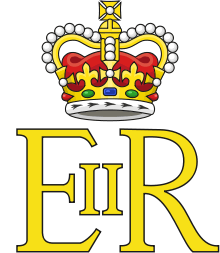Operation London Bridge
Operation London Bridge is a codename that refers to the plan for what will happen in the days after the death of Queen Elizabeth II.[1][2][3][4] The plan was originally devised in the 1960s and is updated several times each year. It involves planning from government departments, the Church of England, Metropolitan Police Service, British Armed Forces, media and Royal Parks of London. Some key decisions relating to the plan were made by the Queen herself, although some can only be made by her successor (the current heir apparent is her son, Charles, Prince of Wales), after her death.
The phrase "London Bridge is down" is expected to be used to announce the death of the Queen to the Prime Minister and key personnel, setting the plan into motion.
Background
Until the mid-19th century, British royal funerals were poorly organised. At the funeral of Princess Charlotte in 1817, the undertakers were drunk. The Times described the funeral of King George IV in 1830 as "ill-managed". This changed during the reign of Queen Victoria, who was obsessed with death,[5] when she started planning her own funeral in 1875, 26 years before she died.[1]
When King George VI died in 1952, key government officials were informed with the phrase "Hyde Park Corner". This was done to prevent Buckingham Palace switchboard operators from learning the news too soon.[1][2]
The funeral plan for Queen Elizabeth The Queen Mother, codenamed Operation Tay Bridge, had been rehearsed for 22 years and, in 1997, was used as the basis for the funeral of Diana, Princess of Wales.[1]
The plan
.jpg)

The Queen's Private Secretary will be the first official (i.e., not one of the Queen's relatives or part of a medical team) to receive the news. The Private Secretary's first act will be to contact the Prime Minister, and civil servants will convey the code phrase "London Bridge is down" using secure telephone lines.[1] The Foreign Office's Global Response Centre, based at a secret location in London, will communicate the news to the governments of the fifteen other countries of which the Queen was head of state (the Commonwealth realms), and to the governments of the other countries of the Commonwealth of Nations.[1]
The media would be informed via an announcement to the Press Association and the BBC through the Radio Alert Transmission System (RATS) and to commercial radio through a network of blue "obit lights" which will alert presenters to play "inoffensive music" and prepare for a news flash, while BBC Two would suspend their scheduled programming for the day and switch to BBC One's broadcast of the announcement.[6] BBC News will air a pre-recorded sequence of portraits, during which the presenters on duty at the time will prepare for the formal announcement by putting on sombre clothing prepared specifically for this purpose. The Guardian has reported that The Times has eleven days of pre-prepared coverage ready, and that ITN and Sky News have long rehearsed her death, but substituting the name "Mrs Robinson".[1]
A footman would pin a dark-edged notice to the gates of Buckingham Palace. At the same time, the palace website would display the same notice.[1] Parliament would be recalled. If possible it would meet within hours and the Prime Minister would address the House of Commons.
In the days that follow the announcement, The Royal Mint would begin producing new coins with the new Monarch's image on them, for issue upon his or her accession. (Though, per the Demise of the Crown, the new monarch will have succeeded — become monarch — the moment Elizabeth II died.)
The day after the Queen's death, the Accession Council would meet at St James's Palace to proclaim the new Monarch.[7][1] Parliament would meet that evening when MPs would swear allegiance to the new Monarch.
Different arrangements for moving the Queen's coffin are planned depending on where she dies. For example, if the Queen dies at Windsor Castle or Sandringham House, it would be moved by car to Buckingham Palace within a couple of days. If the Queen dies overseas, it would be brought by No. 32 (The Royal) Squadron to RAF Northolt and then by car to Buckingham Palace. If the Queen dies at Holyrood Palace or Balmoral Castle in Scotland, the coffin would first lie in repose at Holyrood Palace followed by a service of reception at St Giles' Cathedral in Edinburgh. Following this, the coffin would then be transported to Waverley Station and then taken by the Royal Train to London. In all cases the coffin would be taken to the Throne Room at Buckingham Palace. Four days after the Queen's death, it would be moved to Westminster Hall and lie in state for four days.
The state funeral would be held at Westminster Abbey nine days after the Queen's death, after which her body would be buried in a prepared tomb at St George's Chapel, Windsor Castle.[1]
Name
Funeral plans for deaths in the British royal family generally have names of prominent bridges in the United Kingdom. Other known names are:
- Operation Tay Bridge, the funeral plan for Queen Elizabeth The Queen Mother.[8]
- Operation Forth Bridge, the funeral plan of the Duke of Edinburgh.[1]
- Operation Menai Bridge, the funeral plan of the Prince of Wales.[9]
See also
- Operation Hope Not, funeral plan for Sir Winston Churchill.
References
- 1 2 3 4 5 6 7 8 9 10 11 Knight, Sam (16 March 2017). "Operation London Bridge: the secret plan for the days after the Queen's death". The Guardian. Retrieved 17 March 2017.
- 1 2 Oppenheim, Maya (16 March 2017). "This is the secret code word when the Queen dies". The Independent.
- ↑ Bowden, George (16 March 2017). "5 Things We've Learned About 'London Bridge' – The Queen's Death Protocol".
- ↑ Meyjes, Toby (16 March 2017). "There's a secret code word for when the Queen dies". Metro.
- ↑ "A Victorian Obsession With Death". www.berkeley.edu. Retrieved 2018-02-13.
- ↑ Gogarty, Conor. "Operation London Bridge: This is what will happen when the Queen dies". Gloucestershire Live. Retrieved 26 August 2018.
- ↑ https://privycouncil.independent.gov.uk/privy-council/the-accession-council/
- ↑ "A week of mourning for the last empress". The Guardian. 1 April 2002.
- ↑ "The Insider – Paul Routledge". New Statesman. 17 June 2002.
